
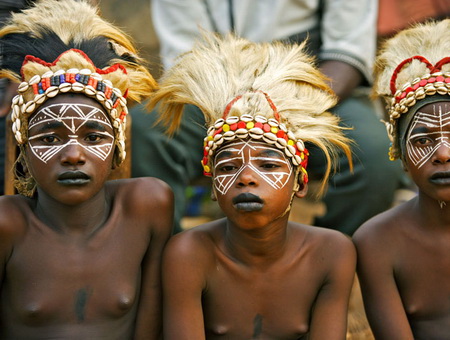
According to a recent estimate, the archipelago is inhabited by 15,000 to 20,000 people, 90% being Bijagos. In the census taken in 1950, the Bijagos numbered 9,200, being about 2% of the total population of Guinea-Bissau. This figure is the lowest ever recorded as previous counts have given a much greater number. In 1935, Landerset Simoes calcutaed 25,000, and in 1889 the Governor Joaquin da Graca Correia e Lanca estimated their population at 50,590.
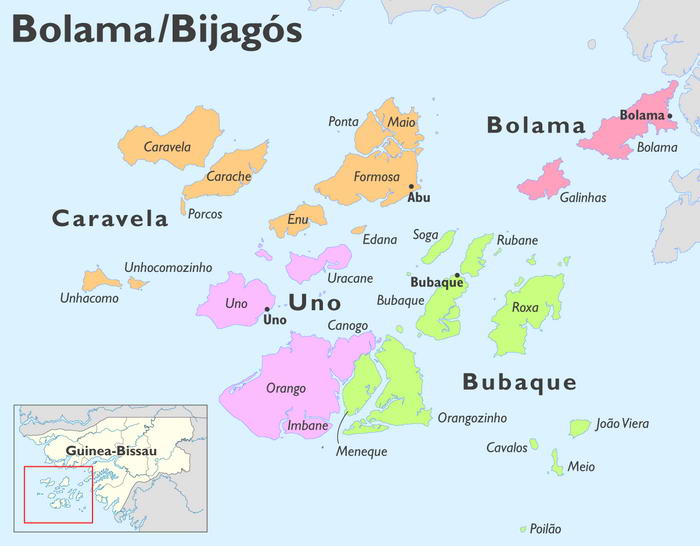
The Europeans requested laborers for their experimental farms and for palm oil production. The bijagos were requested to help build houses, roads, and the port for the center of Bubaque.
This caused a psychological stress on the people, and broke forever the agricultural cyclic rhythm the Bijagos had had for centuries. They were accustomed to hard agricultural work during the rainy season, and fishing, picking fruit, and performing the mandatory religious ceremonies during the dry season.
At present, they have been unable to stop the encroachment of wild plants in the woodland close to the villages. Today, almost every village of the island is surrounded by the wild forest. Fruit trees are scarce, and the fruit is often eaten by monkeys who can arrive close to the houses because of the many trees. Further evidence of the decline of the Bijagos' economic life is the ruins in some villages which indicate the prosperity they'd enjoyed just two or three generations ago.
Since independence, there has been more efficient medical care and primary schools are available for the first time for all children. Some villages are regaining new vitality and hope for future prosperity and growth.
Some of the elders of Bubaque told me that the coming of the Europeans to the island, the British and German settlers first and the Portuguese later, was a disaster for the Bijagos people. They were used to a free and independent life in the islands, with plenty of fruit and with enough cleared land around the villages for cultivating mandioca, peanuts, beans, and other kinds of fruit and vegetables. They had ample rice cultivated by means of the slash and burn technique. They were not able to accept the kind of work imposed by the Europeans. They could not satisfy the demands of the newcomers who were more powerful. |
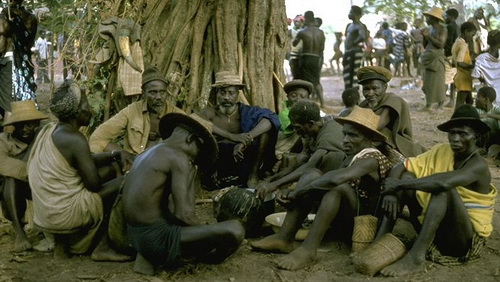 |
The island of Bubaque, with an area of 48 sq. km. of which 18 are swamps and covered by the ocean during high tide, is located in the southeast corner of the archipelago. It's the island most affected by the presence of Europeans, chosen by the German settlers before World War I and by the Portuguese Government after 1920, as the main center for their activities in the archipelago. The Germans built a factory for the extraction of palm tree (Elaeis guineesis) oil; a port for ships of small and middle tonnage in the northern part of the island; and an experimental farm in Etimbato. During the colonial occupation, which ended in August 1974, Bubaque was the center of the administrative offices of the archipelago, with a resident Portuguese administrator and other officials. In 1952, a Catholic church with a permanent missionary and a Protestant mission started operating on the island. The construction of a small hotel for tourists increased the presence of Europeans. The long beach of Bruce, situated on the southern part of the island, is a special attraction for tourists and is linked to the administrative center of Bubaque by a paved road built in 1976.
Communications with Bissau are possible by small airplanes and by ship. One vessel with a capacity of 200 passengers comes to Bubaque every Saturday and returns to Bissau the following day. More hotels and a large airport are now being built to increase the tourist capacity of the island.
The climate is subtropical with an abundant rainfall, with an average annual precipitation of 1500-2000 mm, during the rainy season, from mid-May until mid-November. The average temperature is about 33 C (94 F) during the dry season and 25 C (77 F) during the rainy season, but the daily temperature range is quite variable. At night, especially between December and February, the temperature drops 20 to 30 degrees F and people must take shelter in their huts to warm themselves.
Most of the island is covered by oil palms, whose cultivation and growth was improved by German settlers at the beginning of the century. The other vegetation, of the woodland type, includes a variety of plants of the subtropical region. the most important big trees, often the sacred centers for religious cerimonies, are the so-called wool trees (Eriodendrum anfractuosum) and the baobab (Andansonia digitata). Around the outskirts of the villages, the most common fruit trees are mangoes, cashews, oranges, lemons, and pawpaws. The game found in the islands (gazelle, wild goat, hippopotamus, crocodile) have disappeared from the island of Bubaque. However, monkeys and weaver birds (Proceus cucullatus), so dangerous for agriculture, are still numerous.
In November 1976, the island contained 2,172 people. About 757, half of them not Bijagos, lived in the center of Bubaque and 1,415 lived in the island's twelve villages.
The average stature of the Bijagos is 1.70 meters for men and 1.63 meters for women. Like most people of the West Atlantic group, their skin color is brown with some gradations of very intense brown. They have little body hair, and the young males wear long hair, usually kinky and braided in the same fashion as the women. Because of the presence of administrative offices and schools built in the last thirty years, Bubaque has the highest percentage of literacy in the archipelago.
The Bijagos agree that two or three generations ago the villages of the island were more heavily populated.
The Bijago elders agree on one point, that life was much easier and better before the arrival of Europeans on the island. "When we were young," they would tell me, "we had much more food than now, the forest was rich in fruit and the sea in fish and molluscs. The elders did not have to work as today, because food was provided daily by their sons." In fact, the enevironment of the island is quite generous for people living on a subsistence-based economy. The principal economic activities are: a) Cultivation of the primary crop, rice, and of other secondary crops, such as peanuts, beans, maize, yam, mandioca, and squash. When low tide leaves an extensive part of the shore with plenty of clams, cockle shells, and crabs, these are gathered by the women. |
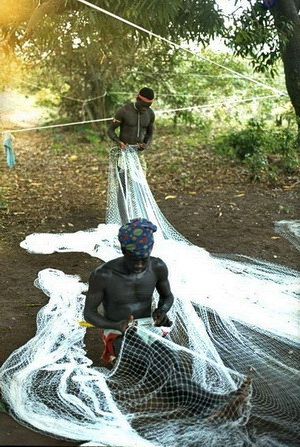 |
Bijago people use the slash and burn technique, with a rotation of the land exploited every five to seven years. All the families of the village gather together in February and decide which land to cultivate, dividing it according to their needs. Although some of them have gardens for irrigated rice, the pincipal agricultural work is with upland rice. The land has to be prepared during April and May, just before the first rain which usually falls in the second half of May. Men cut the woodland and burn it. The women, seed, weed, protect the crops from monkeys and birds, and finally harvest.
The cutting of the forest, the weeding, and the harvest are done by large groups of people working together on each other's fields. The only pay is to provide the food for the day along with abundant palm wine and tobacco. Those who are affluent and have enough rice usually prepare the larger and better fields.
Every married woman has a plot of land for rice for her children. Unmarried girls have smaller plots of land, near that of their mothers, for the rice they will use for religious cerimonies and feasts with their peers.
On the rice field, usually at the perifery, the Bijagos may plant maize, guinea corn, millet, watermelon, pumpkin, yam or squash, but only in small quantities, for family needs or for the fun of trying new crops. The farming for upland rice is a hard and unrewarding job. women and children have to spend whole days in the fields protecting crops from birds and monkeys.
The harvest, being heavily dependent on the regularity of rain and on good soil, is seldom sufficient for the whole year. In Bubaque, people have to rely on the rice sold by the government at the local markets, which is usually very scarce. The people are helped to survive from August to October by harvesting palm oil and gathering molluscs found on shorelines, and by the fruit of the mangroves, called "egba" (Avicennia germinans).
On the outskirts of the village, land is cleared for secondary crops, namely peanuts, sweet potatoes, mandioca, and beans. These can grow every year by rotation on the same plot, with little fertilizer except the burning of grass and weeds grown from the previous year. Seeding and planting is always the task of women, although the contact with Europeans has induced the men to also seed and plant these secondary crops.
Peanuts and beans, along with palm oil and domestic fowl, are the most useful means for acquiring the money needed for buying clothes and paying annual government taxes. Today, because of Portuguese influence, the Bijagos grow the regular "European" peanuts, but in ancient times they only grew the so-called mancara bidjugu (Bambara groundnuts), with the flavor of fava beans.
Most of the island of Bubaque is covered by the oil palm (Elaeis guineensis), whose cultivation was encouraged by the colonial government. There is a local factory with large production of palm oil for export. The palm trees, however, were not well-cultivated because they grow among wild trees. Often they are damaged by the slash-and-burn technique used in rice cultivation.
The oil palm trees serve two important purposes in the Bijago economy. One is to providethe wine used as a common and less-expensive alcoholic beverage for the religious ceremonies, offerings, and feasts; it's obtained by tapping the stem of the unripe fruiting bunch. A good palm tree can produce a quarter of a gallon of wine daily for ten to fifteen days. The best wine is produced during the dry season, between November and May. This is when most feasts are celebrated, and most of the important work is done, such as the building of houses and preparation of rice fields.
The trees' second purpose is to provide a reddish oil used in nearly every dish of Bijago cooking. It's used not only for cooking, but also to annoint the body and hair and also for some religious purposes.
The most important are cattle, goats, sheep, and pigs, but fowl (chickens, ducks, and guinea fowl) are also raised. Cattle are scarce on the island of Bubaque due to the poor grassland, and especially because the Portuguese administrator had forced the owners to provide the local market with meat at least once or twice a week. The Bijagos do not kill cattle except for religious ceremonies that require the blood of a cow or bull.
Pigs, goats, and fowl are plentiful, roaming freely around the village, and they're marked with a sign that only the owner can identify. In some villages, where stealing of livestock has increased and often goes unpunished, people must carefully watch their livestock. In the past, it was enough to curse the thief in order to recover the livestock or at least to discover its whereabouts.
Pigs may be sold for cash, but are most desired for religious ceremonies related to women.
Chickens are necessary because no ceremony can start without the killing of at least one chicken, no matter how young if no others are available.
Fish are plentiful in the ocean and off the coast. Some fishing activities are related exclusively to men, such as catching fish on the open sea, while women gather molluscs and crabs on the shorelines.
Fishing activities can be profitable for obtaining cash, when a village or group of people obtains a canoe or gill net.
Hunting on the island of Bubaque, excpet for monkeys, small lizards, ducks, and doves, is dying out because of the disappearance of some species of game animals that are still found on other islands (wild goat, gazelle, hippopotamus). The bijago use spears and traps, as only a few people can afford to buy firearms.
Although the elders may remember the usage of bow and arrow, this weapon is not found anywhere except as a toy for children or as a symbolic weapon for religious purposes.
Bijago women have the task of preparing the daily food of the family and, as in some other West African societies, they provide most of the food needed for the daily meal. In the morning, one will go down to the shoreline to gather molluscs, crabs, or oysters, or into the forest to look for wild yam or seasonal fruit. One of the most important fruits collected gathered during the month of October is the so-called egbá. (October is a critical month because all the food reserves run out and the new crop has not yet ripened.) Egbá is the fruit of a mangrove (Avicennia germinans nitida), whose wood plays an important role in consecrating some of the most important religious objects.
Bijago architecture has been greatly affected by the presence of the Portuguese architecture. This is evident in the changing of the houses' designs (even those of the sacred huts), from a round to a square or rectangular plan. They explain that a rectangular plan allows more usable internal space.
Some people have also learned how to make sundried bricks and to make use of a particular type of palm tree (Borassus Aethiopum) for the truss beams of the roof.
Traditionally, however, the houses were very round, with sundried mud walls and thatched roofs sustained by a bamboo truss. This bamboo grows in abundance in almost all the islands of the archipelago. Two to three weeks are usually necessary to build a house, which requires the cooperation of a large group of people in order to do the work as quickly as possible. Men and women are supposed to have separate building tasks, although this rule is seldom maintained today. Traditionally, women were the main builders of the house, with the task of carrying the water, preparing the red mud, erecting the walls, cutting and weaving the grass of the roof, and hardening and leveling the floor with sand and mud. |
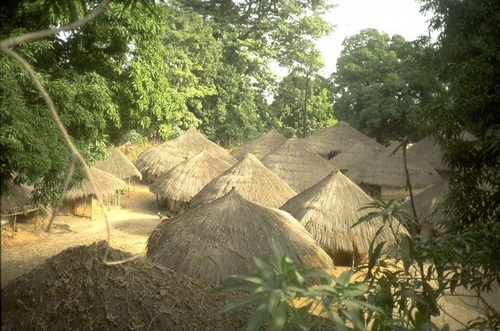 |
Men had to provide the truss poles and the other poles for sustaining the roof, provide the women with cords made out of slices of palm tree fronds, and cover the roof. The house owner has the responsibility of feeding the workers rice and fish, along with abundant wine and tobacco.
The house used for sacred ceremonies has the same round structure and size of the other houses. There are two entrances, without doors, and the internal and external walls are painted with geometrical and mythological designs. The builders of sacred houses are all the married women and adolescent girls of the village - helped by young adults who've just undergone initiation ceremonies and who provide poles for the roof and cover it.
According to the different religious ceremonies, a village may have the following types of sacred houses:
a) The kandjá kamotó - It is the most important sacred house, dedicated to the ancestors of the clan to which the village belongs. It is the responsibility of the village chief's, whoo chooses and elder woman as okinka, to keep alive the sacred fire of the village and care for the religious ceremonies related to women.
b) The kandjá kaorebok - It is where most of the ceremonies related to women take place, under the direct responsibility of the man chosen to participate in some women's ceremonies and his wife.
c) The kandjá eramunde - It is the sacred house for a particular spirit - sometimes borrowed from other ethnic groups - with the power to protect against sickness or to increase fertility. It differs from the other houses because it is privately owned.
d) The kandjá kaunikan - This is where the most ancient spirit Orebok of the island resides. No intitiation ceremony can begin without a sacrifice to this spirit, also called the "spirit of the truth".
All the houses of a village must be consecrated with the appropriate ceremonies.
a) Women's objects
Among clothes, the most important are the traditional grass skirts. There are different styles for married women, adolescent girls, and the female elders, who wear skirts of only one color, usually red. Skirts are died red, black, and white, with different designs according to the different islands. The material used for making the skirts is the fibrous bark provided by the branches of certain trees and shrubs.
Other essential clothing pieces are scarves covering the head, and a cowry chain they fasten around their hips.
On Bubaque, women still wear the traditional costume, except when they go to the administrative center or to school, where it is no longer allowed. Although European clothes and modern fabrics are still expensive for the average Bijago family, it seems that the continual use of traditional clothing is more than just a desire to save money. It is more related to their attachment to traditional life.
In some villages on the island of Formosa, for example, it is common to see all the women and girls, except the female elders, wearing European clothes. In some villages, I found less concern for traditional ways of life than in other villages of the same island.
Other women's objects are those related to the pounding of rice, to cooking, and those related to the important activity of seeding. A mother also has a small basket to hold the bottom of palm oil she uses to annoint her baby. Most of the female elders smoke a pipe or snuff tobacco.
b) The men's objects
Traditional clothing for men is a loincloth of goat skin, cow skin, or the skin of another game animal such as gazelle or wild goat. Today, it is worn only during initiation periods. At other times, the clothing is of European fabric. Two other essencial items which serve as signs of wealth and prestige are the hat (kunkpont) and blanket worn as a mantle when going from one village to another (<i<kapokate< i="">), which can be bought from the European market. Almost all the men, however, are giving up traditional costumes in favor of European ones. They wear shirts and trousers, except when they're doing agricultural work or climbing trees.
The most common objects of a Bijago man are those related to the important activity of climbing palm trees. These are a cord-like belt made from a large palm frond, a chisel-like axe used for cutting the fruits of the palm, and a small chisel for making a hole in the fruiting bunch. From this hole, palm wine runs into their calabash container or glass bottle.
Every Bijago man also wears, attached to his belt, a leather sheath with a long sharp knife. When they travel, they carry a bag, usually made of reeds, containing a cowhorn glass for drinking, a bottle of wine, a smoking pipe, some religious objects, and sometimes the traditional flint and steel - now replaced by the common match.
The staple food consists of rice, palm oil, and fish. I have heard some elders complaining about the present trend of their wives who want to use rice for the everyday cooking. In the past, rice was also a staple food, but not for every day, being alternated with beans, Bambara peanuts, European peanuts, and taro. The fireplace for cooking is always built on the house's veranda, with three round stones to hold the pot or pan. The fish is boiled, mashed, and mixed with lemon jouce, red pepper, and palm oil. Added to rice, it is the most common dish of the Bijagos. Red pepper is abundantly used in almost every dish. As do other tribes of Guinea-Bissau, they eat monkey and most of the small animals and birds found on the islands. They do not eat snakes, vultures, or any kind of insects. |
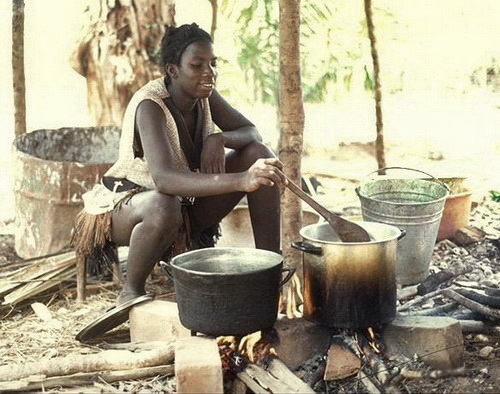 |
The basic political and economic unit of the Bijagos society is the village. It is autonomous and usually self-sufficient. The method of rule most faithful to tradition allows for each village to have a chief, as is the case on Canhabaque Island.
But on the island of Bubaque, where traditions are changing and the new political powers influence every aspect of village life, there are only two chiefs.
Men usually remain in the villages where they were born, with their father and brothers. The younger brothers, if permitted, build their houses close to their elder brother's house. In the past, the children were under the total responsibility of their mothers; now they can stay with whom they like best, but the mother has a great influence until they're young adults. Post-marital residence is virilocal, and a wife's sisters or daughters move to her husband's house. In case of the husband's death or divorce, they may go back to a brother's house.
It was a strict rule in the past that the matricn should be kept exogamous, that no marriage was allowed between two individuals whose mother came from the same clan. The Christian influence (Kristons being those baptised or those living with white people) allowed marriage between cousins, and liberalized the rules of marriage among some Bijagos.
The Bijago people in Bubaque say they are descendents of four apical ancestors, Oraga, Oracuma, Ominca, and Ogubane. Every village belongs to one of these four clans.
Descent is determined matrilineally. Everybody belongs to his mother's clan. This is important for obaining rights over the land and certain religious responsibilities in a village. Those who belong to the same clan as the village chief usually have the best choice when land is distributed at the beginning of every year. Because post-marital residence is virilocal and descent is matrilineal, clans in a village may theoretically disappear if the mothers happen to be all of different clans from the owner of the village.
The matrilineal descent principle reinforces the unity of all the Bijago people, because the four clans are present in all the islands and it does not split the land property of a village, which is protected by the institution of a chief who comes from the same clan as the village. Viilocal residence, however, keeps the real property of the village and the social structure in the hands of the partrikin, reinforcing the importance of the man in the economic structure. This gives stability to farming and helps unify the extended family in spite of divorce and polygyny.
Whan an extended family grows too large, the brothers, with the permission of the elders, can split and form two distinct sections in the same village. A Bijago man, however, never moves to another village, unless it is a new village of its own. If he has to move because of serious conflict with the elder brother, the initiative is taken with pain and loss of prestige and power.
1) There is no distinction indicating sex, except for the terms father (oté) and mother (onsún). Husband and wife are indicated by the same term (osoni). 2) Brothers and sisters are distinguished only by age, such as the older and younger. 3) All sons and daughters are called okpé, without distinction of age or sex. 4) The kin from one's mother's side are the most important, especially for protection and in case of ceremonial duties. In case of death, a person's moveable goods, though often very few, are taken by the members of the matrilineal clan of the dead. For a woman, her mother's sister is the most important person, or her mother's brother. |
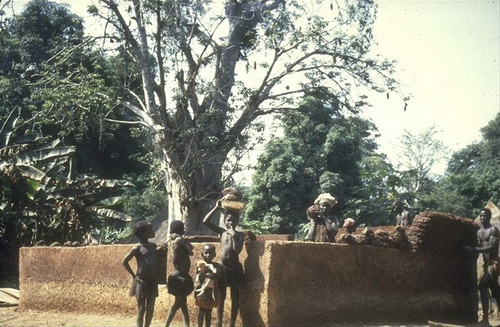 |
5) All the cousins on one's mother's side are true brothers and sisters, and their children are as one's own children. Some see a distinction between the children of their sisters and the children of their brothers. On the father's side, the father's brother is also one's father and the father's sister is also one's mother. The children of one's father's sister become one's father or mother, and the children of one's father's brother become one's children or brothers. The cousins from the father's side are indicated as katiakén and the cousins from the mother's side as otorénh, which means "somebody with whom I share the same mother".
Every village is under the rule of a masculine chief. The chief, usually an outsider, is chosen by all the members of the village. His principal duties are:
a) Responsibility for the worship of the village's guardian spirit (Unikan Orebok). Every day, the chief has to pray and make offerings for the well-being of the inhabitants. b) To preside at religious ceremonies and the meetings of the elders in the central square. c) To keep alive, with the help of his wife, the sacred fire he has received from the Dufuntu the day of his consecration. d) To act as the center of unity for the different activities of the village. Because of the equal opportunities given both men and women in religious and economic activities, conflicts and misunderstandings are frequent in their everyday life. The chief, because of his dealings both with men an women in their ceremonies, is in a position to solve conflicts and restore communication between the parties. |
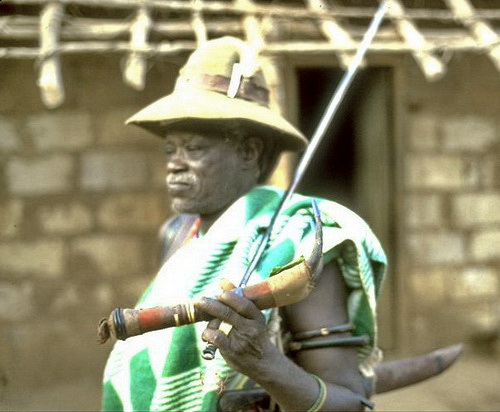 |
His ability to make peace is enhanced because he is an outsider who can act as a true neutral party.
e) To administer justice. Peace and harmony are the two things all members of the village most desire. They believe that when conflicts arise or when an injustice has been done against somebody, the spirits of the village are upset. The harmony between the two worlds is broken and must be restored. Furthermore, if accidentally or purposely some human blood touches the earth, there must be some compensation through the sacrifice of an animal, a cow or a goat according to the gravity of the offense. If no blood was involved as happens in quarrels and some beatings, it is enough to make offerings to the spirit Orebok in the presence of the Council of the Elders. The chief, together with them, decides the amount of restoration to be made in order to please the spirit Orebok and re-establish his protection over the village.
f) To control the land properties of the village and its distribution at the beginning of every agricultural year. This does not mean absolute power of the chief, who very often has to work harder than the other members in order to maintain his reputation and wealth, which enables him to be hospitable to them. Normally, all the land of the village belongs to the chief. The members of the village pay a small percentage of the crops to him, to compensate him for his expenses in the sacrifices performed in the community and to help him be hospitable to the people. They also reimburse him for the time he is away from his farm, performing religious ceremonies. Taxes are much higher and mandatory if members of another village ask to do agricultural work on the land of the village, which happens when people move to the island of Rubane where the land is plentiful.
In March 1976, I had the opportunity to be present at the ceremonies for the consecration of Coia, the new chief of the village of Bruce on Bubaque Island. He'd been selected by the elders of Bruce in 1974, from his village of Bijante, because of his membership to the same clan of Bruce, Oracuma, together with his reputation as a peaceful man and as a skillful and hard worker - all qualities much needed to run the big village of Bruce.
On the night of March 20, at least one hundred people from Bruce came to Bijante to take the chief-to-be and his belongings. He was wearing only a loincloth made of goatskin and his hands were bound. They accompanied him to Bruce and thrust him naked into the sacred hut. The following evening, the sacred drum started sending the message to all the villages of the island:
We have the chief, we have the chief.
God gave us the chief, God gave us the chief.
All those present in the village, men and women young and old, started dancing and clapping their hands for the big event and the happiness it was bringing to everybody.
Many ceremonies were performed in the following days. A cow was killed in front of the new chief's sacred hut, in order to protect his dwelling and to help him deal with the spirit Orebok and the souls of the ancestors. A second cow was killed for the new sacred fire. The Dufuntu built two new houses, the kabango kaunikan and the naó, symbols of the village chief's presence.
During the week of ceremonies, Coia received instructions from the two chiefs present from Canhabaque Island. The chief of Bijante was not present because he was sick and hospitalized, but a messenger was sent to him twice to ask instructions, because the people of Bruce didn't know if they were performing the ritual correctly. This episode deepened my understanding of the Bijagos' attitude toward their religious beliefs and practices; it is not important the technical knowledge as given to them, but actual knowledge from their personal and active participation in the ceremonies, that is to say their personal experience.
The two chiefs from Canhabaque were chosen because of the special relationship between the two islands since ancient times. During the long week of ceremonies, the two chiefs instructed Coia in some of the secrets of Bijago traditions and told of their own experiences.
The tradition is to make gifts when these secrets are given, unless this so-called "secret information" is worthless. The new chief had to reward the informants each time special information was given him, and Coia ran out of tobacco and often had to send villagers to bring more in order to please the two chiefs.
A new life of contacts was established between the living and dead members of Bruce, through the person of the new chief, who had the capacity to talk with the ancestors and with Orebok. A Bijago chief knows how to communicate with the world of spirits. Of course, the competence of a chief grows mainly through the years he stays in office. His knowledge and seniority increase his value among the other chiefs of Bijago society.
Within Bijago society, all the individuals have the same opportunities for wealth and for rank, if they belong to the lineage of the village. It is a general belief of the Bijagos that if one is too superior over the others, he may become dangerous. Furthermore, it is expected that one will share his wealth by distributing some of it among the village's needy. When somebody is asked how many animals he possesses, the answer is never the truth. Many times people give cattle and goats to relatives living in other villages or on other islands, in order to avoid giving them away during certain ceremonies. They try to keep their wealth a secret. They may be accused of witchcraft if they're too wealthy and fortunate. Hard work, however, is always appreciated and considered the main cause of wealth and good luck, as well as success as a lover or spouse.
Land worked with the slash-and-burn technique is divided every year according to the needs of the families. Mango trees belong to all the members of the village, but oil palm trees - especially good ones that give wine continuously - are owned by the families that fertilize them.
Moveable goods, such as animals, clothes, and personal utensils, are personally owned. Most of them are buried or destroyed upon the death of the owner; others are kept by the members of his clan.
Regarding the relationships between men and women, we notice a great respect and freedom for personal initiatives that seems unknown in most societies in Guinea-Bissau.
Adolescent boys and girls live and play together.
Adolescent girls seem to avoid any emotional involvement. Their mothers and the elders warn them to wait and prepare for the coming Dufuntu ceremonies, the mystic union with the souls of the boys who died before performing the initiation ceremonies. The dead boys will choose their bodies for making reappearances in the village. Most girls remain virgins.
The adolescent boys are more free in their relationships with the other sex. Before the initiation ceremonies, a young Bijago man might procreate with a woman.
The life-style of adolescent boys and especially of the young men, who go dancing from village to village and island to island, puts them in a situation of being in love with women fascinated by their strength and beauty. A young man who is a good dancer, and a strong and skillful worker, might develop more than one permanent relationship of this type. A chlid born from this type of relationship belongs to the mother, and her clan takes care of him.
Traditional Bijago society distinguished two types of sexual relationships between men and women:
a) Sexual relationships before the initiation period - A young man does not yet have the right to own a personal home in which to live with his lovers. During the initiation period, all these relationships are ended forever, and none of his previous lovers are eligible to become his spouse in a future marriage. However, this rule is now changing in Bubaque.
b) The real marriage relationship after the initiation ceremonies - After a special ceremony, the wife leaves her parents' or elder brother's house and goes to the new house of the husband.
Some informants told me that in the past a woman would choose her lover and her husband. Today in Bubaque, both men and women take the initiative of the first approach.
In regards to true marriage, Bijago people have a special ceremony in which only those who are married can participate. The elders, both men and women, accompany the bride to the house of the groom, who is waiting and sitting on the bed in his room. The women ask the bride to sit near her spouse. They tell her: "Daughter, look at your husband we are giving you in marriage." And the elders say to the groom: "Take care of the bride, work hard for her and do not let her go asking for food from others. Give her hospitality but send her back to her mother's house if she is barren."
Among the Bijago people, polygamy is the rule. The wives may share the same house, or each may live in a separate house with her children. Meanwhile, the husband may stay alone in his house with the older sons. Sometimes, a wife may choose to live with her parents or elder brother. On this matter, there seems to exist great freedom and variety of choice, which causes divorce to be frequent. The woman has economic security in her clan and family, and she can earn a living in her home village.
Some experts have shown me special plants and shrubs that the women use to increase fertility, to cause abortion, or as contraceptives - for example, when a woman would like to have sexual intercourse during her nursing period. Cultural tradition prohibits any sexual intercourse during a woman's nursing period with her child. If she does have intercourse, they say the milk will stop from her breast and her child's mouth will swell and blister. When the time of weaning ends, the husband who desires his wife may take the child into the forest and give it palm wine and rice; as a result, the mother must stop nursing.
In Bijago philosophy, life grows step by step. You learn from the other village members and from life itself how to adapt to the environment and the social relatinships within and outside the vilage. Children are respected as persons, and there is little or no beating of them. A Bijago child may be seen to cry because of sickness, hunger, or because he has been struck by a peer, but not because an adult has beaten him. If an adult beats a child, soon all the villagers will be criticizing the adult.
Even when the chief and elders have to punish someone, it seems that clemency is always the attitude they adopt.
In a situation in the village of Bruce, adolescent girls were deprived of food. They complained, and the other villagers agreed that the punishment was too severe. The elders had to give a gallon of wine to the girls as an apology for the punishment.
The young are taught to respect the elders and to share their goods with everyone. When the children start to mature and are thought to have the capacity to reason, they meet with the elders. They share some of their goods with them, and by giving they meet and are met for the first time. The lesson of giving and of meeting others by giving is learned forever. The village is the unit of life and growth, not of weakness and individualism.
"Ongbá" (young children 2 to 6 years old)
As soon as the mother realizes that the child is alive in her womb, she starts annointing her abdomen with palm oil to make the baby grow strong and healthy. At this point, she stops having sexual intercourse.
Traditionally, the childbirth takes place in the woman's house with the assistance of the elder women. The umbilical cord is cut with a clam shell. The new mother's mother hastens to give the good news to the father who is to name the child immediately.
The mother fastens a cord around the baby's left wrist and another around the waist, saying: "I put this koratakó (the spirit that protects from evil eye) around the wrist and around the waist of my child to protect him."
At the age of three, the child is weaned. The usual ceremony for weaning is to go to the sacred place where the mother first asked for a child.
"Kadene" (from 7 to 11 years)
A ceremony alerts the boys to respect and obey their parents, and teaches them some skills such as how to cut wood, how to guard the crops, and how to go with the mother to gather mollusks and fruits. During this age grade, they dance with a small drum and wear an anklet made of mango nuts and cockle shells.
"Kanhokam" (from 12 to 17) |
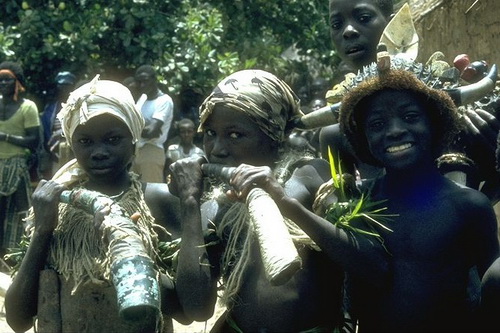 |
"Kabaro" (from 18 to 27)
This is the most joyful period of Bijago life, remembered with nostalgia as the time of freedom, love, and openness to the world. This period lasts until the young men are ready for initiation ceremonies. They go dancing from village to village, especially during the dry season, gladdening the nights of the villagers with the speedy rhythm of drums, and with their songs recalling successful and unsuccessful love affairs. The songs ask for love from all the women who are listening. At this time, the young men have their first children with the unmarried women whom they are in love with. The dancers wear fancy scarves around their arms, metal rings around their ankles, and a sword in their right hand.
The dancers' characteristic horned mask, so famous all around the Bijago islands, represents four types of dances: the dance of the cow, the dance of the bull, the dance of the ox, and the dance of the wild bull.
During this long age grade, the young men have to undergo important ceremonies before passing to the next phase. They must give expensive gifts to the elders and their father. The gifts may be cows, lots of fish, or large quantities of palm oil or palm wine. Furthermore, they have to undergo ceremonial beatings, although these are not so painful. The beatings have two meanings: punishment for all the young men's transgressions, and to prove their strength before the physical sufferings they will soon encounter. The future sufferings are those they will experience after the dancing years are over and they enter the serious period of their lives.
"Kamabi" (from 27 to 35) The Kamabi don't possess anything, not even their own clothes, and have to do the heavy labor of the village. The elders can ask them for any kind of aid, and they cannot refuse. Practically this whole period is spent working and searching for goods necessary to pay the elders. |
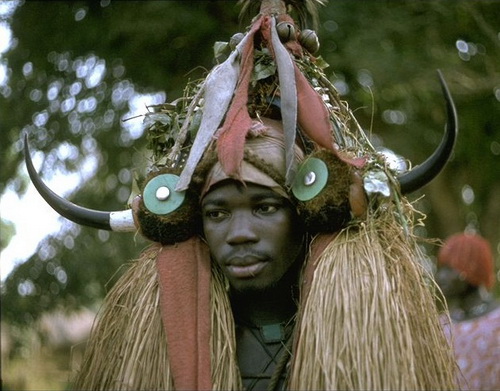 |
They undergo six ceremonial beatings and must make large donations to the elders. They give cows, goats, pigs, rice, etc. It is during this period that friendships grow stronger each day and are friendships for the rest of their lives.
The traditional clothes of the Kamabi are a simple loincloth made of goatskin, a scarf around the head, and a long two-pointed spear together with a shield. Today, the Kamabi also wear European clothes and may take a wife while performing only some of the ceremonies.
What is most important for some is that they should not be allowed to take former lovers as wives. This is a big change from tradition, due to the contact with Europeans, and the elders have preferred to modify the rules instead of letting them lose meaning because of continuous violations.
"Kachuká" (from 36 to 55)
The Kachuká can get married according to the traditional ceremony, build a house of his own, and own land. Usually they wear attractive European clothes, buy expensive fabrics, gold and beaded necklaces, bracelets and earrings in order to be noticed by the women.
"Okotó" (male elders, older than 55)
An elder no longer procreates, he looks after his numerous children and teaches them the traditions.
As he ages, his thoughts are more and more directed toward the day of his passing to the land of his ancestors. He wears only a loin-cloth of goatskin or of European fabric, preserving his best clothes for the day of his burial ceremony.
"Ongbá" (2 to 6 years)
The girls follow their mothers everywhere, helping them to gather mollusks and fruits.
"Kampuni" [from 11 to 20)
This is the age grade of the Dufuntu ceremonies. "Kampuni karák Orébok," says the mother to the girl's father. This means the girl dances in the presence of the soul. Girls passing through the different Dufuntu ceremonies become Kabaro and Kamabi as the corresponding age grades of the males. They wear quite long skirts, dyed red and black. They usually walk in groups with a wooden lance in their right hands.
"Okanto" (married women of 21-50 years)
|
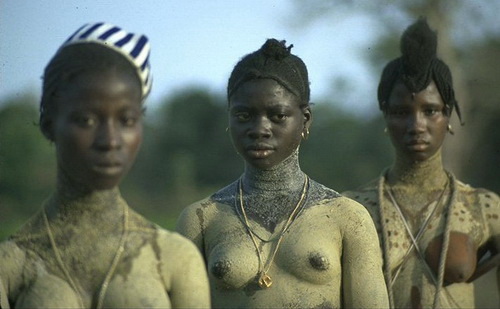 |
"Okotó" (after 50 years)
This group is no longer afraid of the spirits of death, because they have seen them and are able to speak to them in a friendly manner without fear. They are the only women allowed to talk about the Dufuntu ceremonies. The younger women may not discuss these secret and frightening ceremonies, in any way.
The Bijagos are a pragmatic (and artistic) people. In their spare time, they prefer to put their energies into carving wood, traveling from island to island, or looking for palm wine to share in joyful company. They are not concerned with trying to answer deep questions. Often, they say things like: "I do it this way because my elders told me to."
The best way to learn about the Bijago ways of life and style is during the initiation ceremonies. Secluded in the forest, far from the everyday activities, they feel free to imagine, to recall and reshape their world view.
I remember one night when I was talking with Edicok the Chief of Bijante and asking questions about the spirit, Orebok. He told me, inspired: "Do you really want to know something about the spirit Orebok? Talk with him, and he will answer you, telling you what to do. When I have something important in my mind, I talk with him, any time of the day or night."
The supreme being (Nindo) is thought of as a Being who is above everything, difficult to see and be in touch with. The Bijagos also consider as supreme beings, according to their importance, the sun, the moon, the stars, the fire, and the wind.
The spiris are usually powerfully present in statues or objects made for that purpose. Some examples:
a) Unikán orébok -
This spirit is always represented in Bubaque with an anthropological figure. |
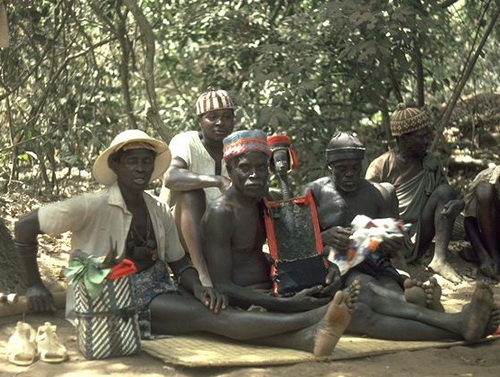 |
Bijagos believe the statue is the dwelling place of the spirit Orebok. Nobody knows what he represents. The most common explanation is that he is the guardian spirit sent by God to protect the members of the village.
Unikán orébok is the living image of the village's history, and the chief is the true interpreter of this image.
b) Unikán ueko -
A person who possesses it cannot be wounded or killed by any weapons because of its magical power. Bullets will not penetrate the human body, and knives and swords will break against it. The most common representation of the unikan ueko is a special material made of different plants mixed with eggs and blood placed into the horn of cows, water buffalo, goats, sheep, or into the big shell of a univalve mollusc.
Before any prayer, the person recalls the first owner and all those dead who took care of that unikan ueko. The people of Canhabaque Island are believed to know its best secrets, because of their successful opposition to Portuguese colonialism.
c) Eramunde etremmate - Like the other sacred objects, it is composed of the material made of various medicinal plants, mixed with eggs and blood. Everything is sealed into a horn. It is the symbol of the magical power of medical practitioners. It is used in healing, discovering the past, and predicting the future. d) Unikán koratrakó -
The term "koratrakó" means any object or ceremony intended to prevent someone from healing. |
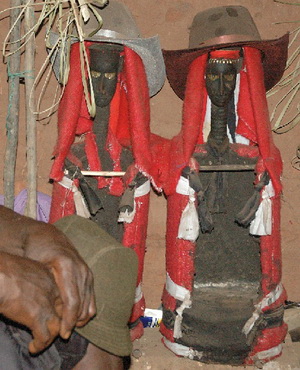 |
The elders say it was very common in the past to commit suicide by hanging, especially for those suffering from irreparable shame or sickness. A person could be drawn to suicide by his belief that sooner or later he would be reincarnated into another body and return to Earth. The Bijago people no longer approve of suicide.
It is a strong belief of the Bijagos that life continues after death. The souls go to a particular place on Unhocomo Island, located on the western end of the archipelago, in the sacred hut called ""kandjá kachanná katammé orébok" (the sacred hut which shows the way to the soul). There they wait for the final passage to the place (kadjoko kanede) where Nindo is.
During the time needed to complete all the funeral rites, the souls can be seen around the archipelago.
There are several types of souls:
Orébok - The soul of a dead person who is awaiting the final trip to the kadjoko kanede.
Oshó - The souls of those who died before completing all the ceremonies, who are wandering around the archipelago, and manifest themselves as the living.
Kasisa - The soul of the soceror, who will never find the way to the kadjoko kanede, and whose place is a particular spot in the forest. These souls are very dangerous to the living and appear especially at night along the roads, as tongues of fire.
After his death, the soul of the chief belongs to the group of ancestors immediately. This helps to view the presence of the ancestors as friendly and welcome and to almost physically experience this presence any time people gather to speak to the ancestors dwelling in the statue of the spirit, Orébok.
The soul can hear the powerful world of the spirits and Nindo, and it may reincarnate into another human body. It is important to maintain the unity of purposes between the two worlds which are parts of the same human reality.
When someone is close to death, the chief or an elder selects a chicken and cuts its throat in front of the spirit Orébok. If the chicken jumps towards the chief instead of toward the statue, there is no hope left for recovery of the sick person. Relatives and friends crowd into his room. To stop death, they touch the body, say friendly things to him, pray and hope, until the soul leaves the body. All activities are stopped in order to start preparing the funeral rite. The elders take the corpse to the seashore to bathe it. Nobody seems afraid of the dead. They talk with the corpse as if the person was still alive. It is common belief that every death is caused by something or someone. If the dead person is young or if death came suddenly, nobody will be at peace until an acceptable reason has been found. If the corpse touches the poles of a house on its way back to the village, this is a warning that the inhabitants of that house are in some way responsible for the death. Therefore, everyone gets out of the way when the group carrying the corpse enters the village. |
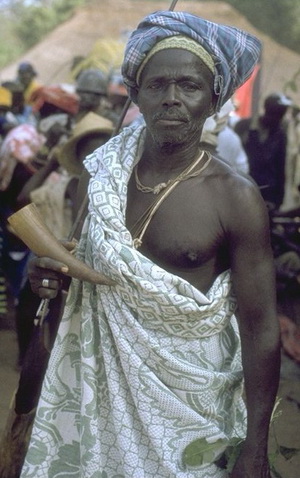 |
The funeral rites are performed in three distinct stages:
a) The burial ceremonies -
The corpse is laid down in the middle of the village at the chief's place, with its face toward the sunset. The body is clothed in a loincloth or two grass skirts, according to the sex.
Important is the killing of numerous chickens, which will reaveal something about the cause of death by the manner they jump after being killed. The different interpretations are these:
- The chicken jumps toward the calabash, located between the spirit Orebok and the offerings. This means that the dead person robbed something.
- The chicken jumps toward the corpse. This means someone caused the death and the dead person will reveal who is responsible.
- The chicken jumps toward the spirit Orebok. This means that the dead person or his lineage is responsible for some misdeeds related to the religious ceremonies. The spirit Orebok will reveal the real cause.
- The chicken jumps outside the circle, into the middle of the grass. This means the dead is responsible for his own death, because he was a sorceror. In this case, he must be buried outside the village in the forest, without any further ceremony.
The corpse is rolled in a mat. Near the head is put one pot of rice, and one of water. The corpse is put into a circular hole one meter in diameter and one meter deep. The elders stand by the grave for five days and nights.
b) The djongago - These are other ceremonies that will reveal the cause of death. The djongago is a coffin-like structure made of bamboo poles. Inside the structure are placed leaves and branches of a special plant, which are believed to recall the soul of the dead person.
On the night of March 3, 1976, I was present in the village of Bijante at the djongago rituals for the death of the young adult, Bida. He had died mysteriously on the island of Rubane. Many people gathered. Suddenly, the djongago arrived. The two men carrying the djongago stood in front of the Unikan Orebok, moving in mysterious ways. One of the male elders began questioning the djongago about the cause of death. The answers are determined by the way the two men move the djongago. One of the men told me that he didn't know he was doing, as if the djongago was directing its own actions. It was very heavy as if the corpse was still in it.
Some of the following questions were asked during the night: "Had the deceased stolen something? Did he commit a wrongdoing against the spirt of manrach? Did he fight someone?" To all these questions, the djongago answered no. But when one person asked if someone of the deceased's lineage may've been responsible for the death, the djongago first approached the elder who'd given the question, and then, after the question was repeated, it approached the statue of Orebok and itself bowed. It signified a "yes" answer to the question. The mother of the deceased rose, expressing her pain for the loss of her only son: "No kanano mo dikidik mocanamme i Nindo." This means, "I accepted it because everything is the will of God." A young adult of the same age grade as the dead stood up, warning the crowd that his "age group" would kill that person if he dared to cause the death of someone else. At that moment, a male elder related to Bida stood and touched the djongago, stopping any further questions. It was the signal that everything had been understood and the rite was over. I was told later that the elder wanted to stop any more specific questions that could have driven the djongago to give answers embarrassing some of those present.
Years ago, somebody found guilty of another's death would be executed. That is no longer true today. On the same night of the ritual, the djongago is cut into pieces and burned.
c) The Mourning Ceremonies -
Bijago people believe the dead continue to share in the live of the village. The mourning rites are an occasion to invite the people to a joyful gathering. There is food, drink, and tobacco, and then they talk about the good qualities of the deceased. No one is allowed to mention his name. Some affirm that they've been in touch with a dead relative in their dreams and also during the daytime.
One man told me he once saw his wife wandering around the ocean looking for fresh water. He gathered the people in the sacred hut and killed a chicken, asking the soul what she wanted. The chicken jumped toward a pot of water. The fact was interpreted as a warning to perform her mourning ceremonies, as soon as possible, so she could find the way to the land of her ancestors.
Someone saw the soul of a friend who died on Bubaque Island passing through a sacred hut on the island of Formosa, on the same day of the death while knowing nothing of the friend's sickness.
The soul is seen as a shadow wearing a loincloth or grass skirt.
There exist initiation ceremonies for the men (manrach) and for the women (Dufuntu). Only men can have the manrach, while the women perform the Dufuntu ceremonies not for themselves but on behalf of dead boys who have entered their bodies.
The manrach is so important that a special spirit was created for it: the iran di fanadu. When the young men enter the sacred place of the manrach, they belong to this spirit and can only do what they are told to do. If somebody dies, no one can blame anyone, because it is the will of the spirit. If somebody is found guilty of serious transgressions, he could face the death penalty in order to restore peaceful relations with the spirit.
The initiation rites are the times of repeating the traditional ways of life. The male elders, by helping the young men to accept Bijago traditions, recall wha they were told and what they have learned through the experience of life. Secluded in the forest, they are able to reshape the Bijago world view and adapt it to the new situations that are present to them. They have abolished circumcision because it was too dangerous for the young people. They are changing the old rule of Kamabi, which required strict celibacy for at least five to seven years.
Bijago people say that the parents are able to physically raise their children, but unable to properly train their feelings and minds. The elders need to put the young through the manrach, so that they may be born into the cultural traditions of the village. The manrach teaches, through discipline and obedience to elders, how the young should control themselves and subordinate their personal ambitions to the good of the community. A good Bijago is not selfish but keeps the clan in mind.
A sixty-year-old person who is performing the initiation rites receives the same harsh treatment as a younger person. To indicate this rebirth into the Bijago world, the new young adults of Uno Island imitate the voice of children when they exit the manrach. They have just started to see again the light of the world around them.
On Bubaque Island, the spirit Orébok of Ancamona Village controls the realization of manrach. All the villages have to ask, through an important ceremony where they kill a cow, the power to have the sacred fire for the manrach.
The manrach, which in the past could last between six months to two years, is remembered as the time of harshness, of punishment, of many teachings from the elders and the period of isolation from the happy life of the village and friends. The main teachings are about agricultural labor and craftsmanship, ceremonial and funeral rites, and especially about the fundamental values of Bijago traditions. They teach the young to respect the elders, to be hospitable, to share with everyone. a) The period before entering the forest |
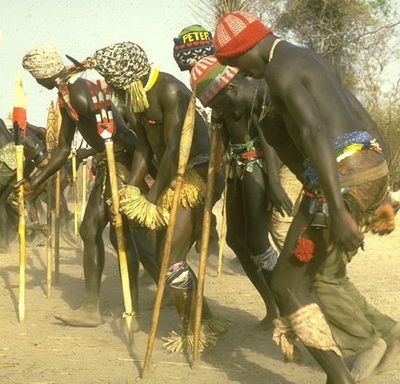 |
After each of the young men has recognized his parents in front of everyone, and has acknowledged his true lovers by giving them gifts, the long night of dancing and greetings begins. The next day, they enter the manrach. Mothers and women of the village shed tears, and the others cry and scream. From this moment, the young men become young adults belonging to the spirit of manrach.
b) The period of “manrach“
Everybody has to obey and learn from what he is taught. A great deal of teaching is done via the experience of a new life in the forest, far from the life of the village. The participants are in touch with nature, the elders, the ancestors, and the spirit Orebok. It is a new psychological and religious experience. They are not being shielded and are free to absorb, accept, and adjust their mind and emotions to the new environment. The friendly voices of the forest, the obedience to the elders, the rhythmic talking of the sacred drum, and the determination to keep the secrets will never be forgotten for the rest of their lives.
In the past, the Bijagos had the rite of circumcision. It is now discontinued due to the heavy death toll that followed it. They say that the tattoos on the chest and stomach are substitutes for the circumcision. Duing the old manrach, some died because of disease or transgressions. The news would have to be sent to the mother by a messenger, who breaks in front of her the pot which belonged to the dead son. All those present understand and no questions will be asked. The death is both the will and the price of the manrach.
The first days are very difficult, because of the scarcity and quality of the food. There is rice without fish nor meat. There are also ceremonial beatings. After the important ceremony of the bath, the initiates receive a new name, wear a loincloth, and eat much better. At this time, the elders begin to teach. Each elder teaches the subject he knows best. The young people are advised how to ask things of the spirit Orebok and how to greet each other. When two Bijago peers meet, they first shake hands calling each other his proper name from the manrach; then, each of them brings his hand to his heart, shakes hands again and brings the right hand to the left shoulder. Another important aspect of the manrach is to recognzie the rhythms played by the sacred drum.
c) The last day of the "manrach“
The sacred drum announces the arrival of the new young adults. The huts that were used during the initiation ceremonies are burned. The young adults arrive, their faces covered with scars, clothed with palm leaves and carrying a long wooden spear and a shield made of reeds. They perform the dance of the young adults. They first recall the deeds of the ancestors. They represent rowing with the big war canoe of the Bijagos, with the bull head on the prow, and finally they play out various acts of everyday life, such as monkey hunting, seeding, and grinding rice.
The long and hard path toward full adulthood has just begun.
Bijago people have a strong belief that if a boy dies before performing the intiation ceremonies, he is unable to find his way to the land of his ancestors. The soul will walk around the villages and roam from island to island, restless, unhappy, and sometimes harming the living. Only if he has the possibility of entering a human body to perform all the missing ceremonies, can he become an adult and find the desired path (kadjoko kanindo). The soul usually enters the body of a girl during the time when her child's body becomes a woman's body.
The relationship with the dead soul is seen, especially by women, as a necessary evil and considered a dangerous experience. They cannot control this, except by accepting it and doing what the dead tell them to do. The sacred drum, though the communicative rhythm of its beats, is the only means they have to listen to the desires of the dead. The mother of a boy who died at a young age recognizes in the dancing girl the presence of her son. The girl will never remember anything that happens to her a few days later. It is as if she has disappeared to another world, without leaving any memory. The long process of the ceremonies gives the women a high status; normally, only a man experiences the manrach. The only chance for a woman to experience it is through the soul of a dead boy. Thus, the woman can obtain the same social status as a man, which could be considered as a woman's emancipation. A different theory explains the Dufuntu ceremonies by a convergent parallelism with a man's initiation rites. A man becomes a full member of Bijago society via a second birth, the manrach. A woman, in order to become a full mother and a full creative member of Bijago society, must give birth both physically and spiritually. |
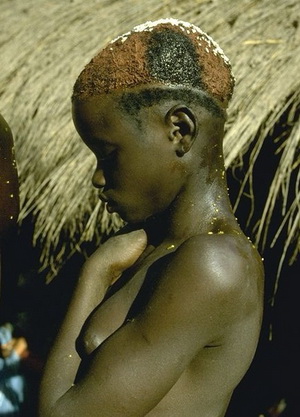 |
It is a characteristic of Bijago society to recognize the importance and dignity of women. A son will never offend his mother, believing that she - through a special ceremony performed in the morning on the seashore - recall him back to her womb.
Women's ceremonies are performed in sacred places in the forest, different from those of the men. No men can enter the sacred place, except the chief and the orase; the latter are the men selected by the elder women to do the heavier work during the ceremonies and play the sacred drum.
The girls live in the forest from two months to a year. This is preceded by a great feast and dancing all around the village. The girls wear the long grass skirts of the Dufuntu. The souls start to call them, n'unté, which means "wife". When the sacred fire comes from the village of Ancamona, the girls are invited by the sacred drum to enter the forest.
one of the main purposes of this period is to teach the girls agricultural work and how to gather wild fruits of the forest or molluscs on the seashore. It is said for the girls, like the young men, this period presents elements of harshness and punishment. Others did not agree with this viewpoint.
An important part of the ceremonies is the learning of the language, dances, and songs of Dufuntu. Each girl acts out a specific dance, according to the will of the soul inside her.
The songs are related to the dreams, hopes, and disappointments of everyday life. The girl and the mother of the deceased recall these in front of everyone, in order to receive consideration and help. The songs act as a catharsis for the mother, and it helps relieve her of the suffering and pain she feels from his early death. The mother asks for compassion and help from the souls to bring her health and prosperity on Earth. The day the girls come back from the forest, they wear a pair of trousers and men's shoes. They are covered with palm leaves and have a triangular hat on their heads. They dance for three days. |
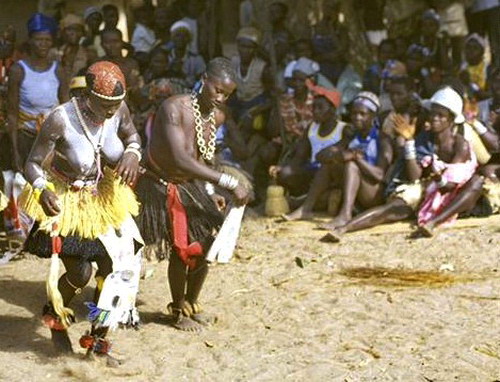 |
When the dancing is over, the girls return to their real status. They stay in the place of the elders for ten days, wearing beautiful skirts. Many visitors come to greet the girls and congratulate them. From this time on they are called Kamabi, like the young men. Like the corresponding men's age set, they start making offerings to the female elders.
At least once a year, the girls will again receive visits from the souls.
These are unpredictable events. They can be related to a big event, such as the death of the chief or another calamity. The villagers interpret these calamities as punishment for their transgressions against the spirits. The Dufuntu, through their ceremonies, will restore harmony.
Bijago life in the archipelago remains difficult and unpredictable. The endemic diseases, such as malaria and elephantiasis, and the uncertain food supply help make the villages believe that their existence is a continuous gift from God. "If God helps," is the usual expression. Life, food, and harmony come from the world of spirits and not from man.
Using religious ceremonies, some Bijagos have the skill to fight sickness and combat misfortune.
The killing of a chicken is an important role during the ceremonies. The chicken jumps in its convulsions, revealing many things to the Bijagos:
1) Misfortune is possible if the chicken does not jump at all.
2) The best luck is when the chicken, after jumping all over, lands flat on its shoulders. This means that the spirit has already accepted the dialogue. If the chicken lies on its side, it means that the spirit is watching, but you must wait for a further sign. Also, it is good luck if the chicken ends up lying on its neck and facing east.
3) Usually, it is believed that the chicken has to pass close to or touch all the persons involved in the ceremony, and then return to the spirit Orebok or to the sacred stool.
4) If the chicken jumps and twirls itself, this is a sign that someone in the village is close to death.
Many times, the killing of a chicken can resolve a situation of uncertainty with a quick answer to give the people direction.
In these ceremonies, it's important that the people eat together. On some occasions, when people are very upset because of a calamity, they kill an animal and throw it into the forest as an ultimate appeal to the spirit.
There exist ceremonies for: the religious consecration of people and objects; the cultivation of rice; to ask protection for new crops; to ask for rain or stop its excess; and to ask for a pleasant journey, a pregnancy, or other necessities.
There is also a ceremony asking for the death of an enemy. It is performed with a chicken and an egg.
Plants used for medical purposes are called unikan, which means "medicine". They are effective. For example, the medicine to treat snake poisoning is very effective. Become of the autonomy and self-sufficiency of the village, the powerful class of medical practitioners has not developed in the same ways as in other societies of West Africa. But, some villages have skillful people with knowledge of the healing powers of the plants. These medical practitioners also develop skills for predicting the future and performing tricks. |
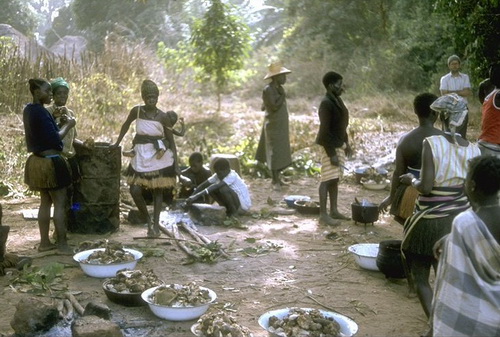 |
One has to start early in life to recognize the different plants of the forest, and must find someone to train him. A father may never tell his son nor a close relative the knowledge he possesses, unless he is paid the price he demands. It is a Bijago belief that it is worthless and dangerous to tell people your secrets without being rewarded. The medicine may lose its effectiveness, and the world of nature will withdraw its cooperation and harmony with the world of man.
The practitioners rely heavily on religious ceremonies for the efficiency of the medicines they use. Great importance is given to the powerful world of the spirits, in the healing process.
Those medical practitioners who engage in evil practices for the sake of harming people belong to the category of sorcerors. They might live in the village without being recognized. Sooner or later, however, they will be discovered and expelled. The religious ceremonies have the power to create friendly relationships between the people. Once, while I participated in an important ceremony with two Bijagos, one of them said to me in front of the spirit Orebok: "Now, we cannot refuse anything to each other. I would give you everything I possess." |
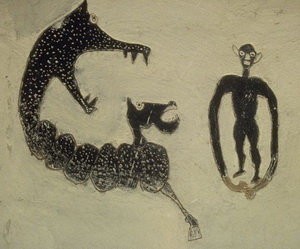 |
The autonomous social structure of the village and the archipelago's relatively rich environment fostered a spirit of independence in the Bijago people. They believe in free initiative and resisted colonial pressures that opposed their independent style. Some colonial administrators labeled them a lazy people, unwilling to undertake hard work. this judgment, however, does not give the true picture of their attitude toward work.
When the food supply is abundant, the Bijagos prefer to indulge in feasts and in ceremonial duties, in thanksgiving to the spirits of the village. However, if hard work is required for some specific need of the village, they are able to join forces and do it. What they seem to need is strong leadership which will show them the advantages of the work to be done. It's difficult to find Bijagos who undertake individual initiatives. They do most of their work communally.
All the members of the village are equal. The Bijagos will never suffer the presence of someone who puts himself above others, because of his ambitions or good fortune. They feel this generates a feeling of inferiority among the other villagers. If one possesses more than the others, he must share his excess or take on more responsibilities during the ceremonial duties of the village. No one would dare refuse food to the hungry or any help he may afford to those who come to him. Such a refusal would be considered the greatest moral fault. To them, both the miserly and powerful belong to the world of witchcraft, not to the everyday life.
Arriving in a village, one is impressed by the atmosphere of happiness and cordiality about him. Hospitality is an outstanding trait of the Bijagos. They often give the best food and the best bed to their guests.
In their contact with non-relatives and strangers, the Bijago are shy and don't ask for food unless invited to shared a meal. With friends and relatives, however, they are spontaneous, hospitable, and generous. Friendship to them is a gift from God, more precious than a wife or child. To a friend, they will speak in a way they would never do to a wife, and they are sure the friend will keep any secret. In a society where records are kept - not with written contracts but with secret agreements made in front of the village and family's spirits - everyone realizes how essential it is that friendship be sacred.
One thing that every Bijago fears until the day he dies is to be put to shame in front of the village. They are defenseless and emotionally wounded when criticized by others. Some informants have said that in the past, the loss of a good public reputation would be sufficient grounds for a person to commit suicide. The people do everything they can to regain honor lost.
They carefully avoid public criticism of other people, in order that others may spare them the same treatment. One of their common desires is to have a good reputation, to find sincere people to deal with, and to be protected from secret curses and jealousies.
The Etute is a sacred place where the elders gather in circumstances related to the exchange of gifts. The young members of the village often have to offer the products of their work to the elders. It is the common way to be taught the traditions and be considered as good potential members.
To share one's good and respect the elders are the two laws every Bijago should endorse. These seem to be, though it is seldom the current situation on Bubaque, the main characteristics the people want to retain in the villages. In their early history, the more fortunate shared what they had with the elders.
When the Dufuntu go from village to village, one of their purposes is to ask for gifts from the people they meet. It is considered improper and bad luck to refuse to give something to them. There is a story the people tell which reflects the meaning of the activities of the Dufuntu: Once, the Dufuntu saw a man seated in front of his house with some fruits from the palm oil tree. As usual, the Dufuntu asked him to share the fruit. The man refused, however, saying he did not have anything to share, because he already had a wife to support. The Dufuntu replied: "Why do you only share with your wife? Aren't we all brothers and sisters in the village?" The Bijago village and culture could have only survived throughout the centuries because of the transmission of their rules from one generation to the other. To a modern mentality, they appear unwisely loyal to their old-fashioned traditions. They look at the past, not just for traditions' sake but because they've learned that the village can better survive if the members agree on the same rules. Some chiefs during colonialism resisted the modern schools, not because of their inability to understand the advantages of literacy, but because of the many people education took away from the village's communal work. Education, in the hands of teachers who opposed Bijago traditions, would have prepared the children to be of no benefit to village life. |
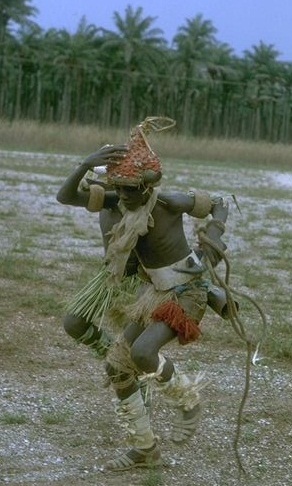 |
This same attitude of resistance has been adopted against Christianity. The Bijagos have avoided serious and responsible dialogue with Christian representatives, though maintaining friendly relationships with them, because baptized people showed little respect for their old traditions.
The Bijago people have changed in the past and are still changing. However, any new policy must earn the loyalty of the elders. New policy must respect the rules and structure of the village; otherwise the Bijagos will resist it as they opposed the naivety of the colonial powers forcing them to become Portuguese citizens.
In this present situation, the Bijago people face danger. Their culture is in danger of being totally wiped out.
Sources: